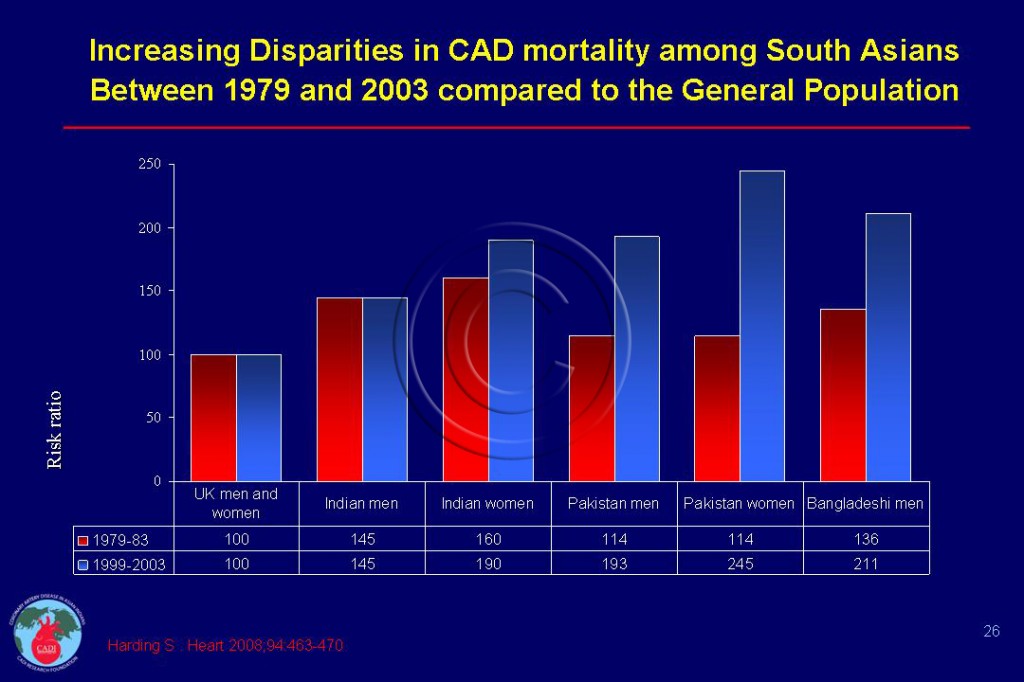CVD in Second and Third Generation Immigrants
- CVD (cardiovascular disease) and its risk factors among immigrants are intermediate with that of country of origin and the country of residence. The disease pattern as well as the risk factor pattern blends with that of the adopted country within two to three generations. Asian Indians and other South Asians have been a singular exception with both patterns diverging instead of converging.1
- Differences in heart disease rates between Asian Indians and Europids have increased over the past 30 years in the UK (Figure 026), but narrowed in Canada, but remain unchanged in Singapore. This may be equally applicable to the second and third generations in these countries.2-4,5-9
- There has been significant decrease in the age standardized CAD mortality in both men and women in the UK between 1979 and 1999. There was significant increase among South Asians particularly women with Indian women having 90% higher mortality and Pakistani women having 145% higher mortality than Europid women (see CADI UK). In this figure 100 is taken as the standard for the whites for both the time periods to appreciate the relative increase or decrease in the South Asian populations.
- The prevalence of obesity and diabetes is higher in children from South Asia and physical activity is lower in young Asian Indians than in whites, even in those with a family history of CAD.10
- Younger second- and third-generation migrants from South Asia need to be targeted to ensure that adverse lifestyle factors are addressed as early as possible.10
- Diet, weight control, and exercise are all important issues that need to be repeatedly discussed from an early age. Such discussion needs to be culturally sensitive, and ideally the whole family needs to be involved.10
- Low birth weight (<2500 g) has been thought of as a risk factor for the development of heart disease and diabetes in adult life. Although the mean birth weight of the South Asian newborns was 3133g it was significantly less than the national average and 8-12% of these newborns had a low birth weight. There has not been any increase in the average birth weight over the past 40 years, and the birth weight of babies of women who were born in the UK are no greater. The persistence of lower than desirable birth weight may result in long-term, higher than average rates of diabetes and heart disease in these groups.11
- A study in the Netherlands has demonstrated the persistence of an unfavorable cardiovascular risk profile in young, third to seventh generation migrated Asian Indians (n= 1790, mean age 36) compared to Europids. Prevalence of most of the conventional and modifiable cardiovascular risk factors was higher in Asian Indians compared to the Dutch. Asian Indians had higher levels of total cholesterol, LDL-C, triglycerides, and lower HDL-C levels than the Dutch.12
- Glucose intolerance was 14 times higher in men and 4 times higher in women. The prevalence of both obesity and central obesity was double in Asian Indian women.12
Sources
1. Jha P, Enas E, Yusuf S. Coronary Artery Disease in Asian Indians: Prevalence and Risk Factors. Asian Am Pac Isl J Health. Autumn 1993;1(2):163-175.
2. Heng DM, Lee J, Chew SK, Tan BY, Hughes K, Chia KS. Incidence of ischaemic heart disease and stroke in Chinese, Malays and Indians in Singapore: Singapore Cardiovascular Cohort Study. Ann Acad Med Singapore. 2000;29(2):231-236.
3. Harding S, Rosato M, Teyhan A. Trends for coronary heart disease and stroke mortality among migrants in England and Wales, 1979-2003: slow declines notable for some groups. Heart. Apr 2008;94(4):463-470.
4. Sheth T, Nair C, Nargundkar M, Anand S, Yusuf S. Cardiovascular and cancer mortality among Canadians of European, south Asian and Chinese origin from 1979 to 1993: An analysis of 1.2 million deaths. C Med J. 1999;161(2):132-138.
5. Fischbacher CM, Bhopal R, Rutter MK, et al. Microalbuminuria is more frequent in South Asian than in European origin populations: a comparative study in Newcastle, UK. Diabet Med. 2003;20(1):31-36.
6. Fischbacher C. M, Bhopal R, Povey C, et al. Record linked retrospective cohort study of 4.6 million people exploring ethnic variations in disease: myocardial infarction in South Asians. BMC Public Health. 2007;7:142.
7. Chiu JF, Bell AD, Herman RJ, et al. Cardiovascular risk profiles and outcomes of Chinese living inside and outside China. Eur J Cardiovasc Prev Rehabil. Apr 27 2010.
8. Khan NA, Grubisic M, Hemmelgarn B, Humphries K, King KM, Quan H. Outcomes after acute myocardial infarction in South Asian, Chinese, and white patients. Circulation. Oct 19 2010;122(16):1570-1577.
9. Gupta M, Doobay AV, Singh N, et al. Risk factors, hospital management and outcomes after acute myocardial infarction in South Asian Canadians and matched control subjects. CMAJ. 2002;166(6):717-722.
10. Khunti K, Samani NJ. Coronary heart disease in people of south-Asian origin. Lancet. Dec 11 2004;364(9451):2077-2078.
11. Margetts BM, Mohd Yusof S, Al Dallal Z, Jackson AA. Persistence of lower birth weight in second generation South Asian babies born in the United Kingdom. J Epidemiol Community Health. 2002;56(9):684-687.
12. Liem SS, Oemrawsingh PV, Cannegieter SC, et al. Cardiovascular risk in young apparently healthy descendents from Asian Indian migrants in the Netherlands: the SHIVA study. Neth Heart J. Apr 2009;17(4):155-161.


